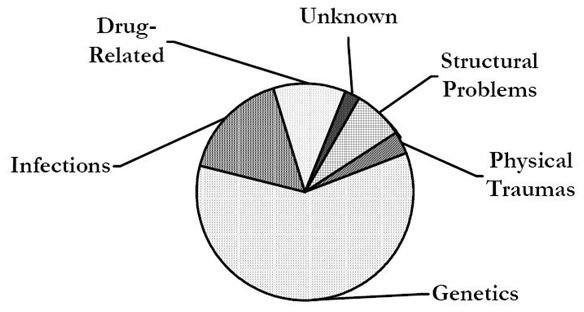Types of Hereditary Deafness: Syndromic and NonSyndromic
What is Hereditary Deafness?
Based on numerous researches and information on hearing impairment, there are many ways to classify hearing loss. It can be classified according to the part of the ear that malfunctioned. If hearing impairment is due to something that went wrong in the outer or middle ear, then it is called conductive hearing loss. If deafness is due to problem in the inner ear, then it is called sensorineural hearing loss. Hearing impairment can also be classified according to when it happened. If the deafness in children happened before the development of language skills, then it is called prelingual deafness. If language has been acquired before losing the ability to hear, then it is called postlingual. The most popular method of classifying deafness is according to the cause. If there were environmental factors that led to the loss of hearing, then the impairment is considered acquired. If the hearing impairment can be traced to the inherited genes, then it is called hereditary deafness. The majority of cases of hearing impairment are considered hereditary.
Types
The unexpected aspect of hereditary deafness is that, sometimes, the loss of hearing can happen in later childhood. Deafness may not manifest immediately. The terrifying part is that more than a hundred genes, when mutated, have been linked to hearing impairment. The various types of hereditary deafness can be grouped into two: syndromic and nonsyndromic. The Center for Hereditary Deafness of the Harvard Medical School estimated that about 30% of all genetically caused hearing loss can be considered as syndromic. The other 70% is nonsyndromic.
Syndromic
Syndromic deafness is characterized by the presence of other health issues besides the loss of hearing. The National Institute On Deafness And Other Communication Disorders has identified more than 200 forms of syndromic deafness. Most of the genes responsible for syndromic deafness have mutated. Some of the forms of syndromic deafness and their medical problems are the following:
- Alport Syndrome - Kidney problems
- Jervell and Lange-Nielsen - Heart problems
- Pendred - Enlargement of the thyroid
- Usher Syndrome - Progressive blindness
- Neurofibromatosis Type 2 -Tumors occurring in the nerves used for hearing and balance
- Waardenburg Syndrome - Changes in the skin pigmentation
Nonsyndromic
The nonsyndromic type of hereditary deafness is further classified into dominant and recessive subtypes. Only about 20% of nonsyndromic cases are dominant. The case is dominant when one of the parents carries the gene that caused hearing impairment. Most likely, this parent is also suffering from deafness.

The case is recessive when both parents have a gene that can lead to hearing loss but they don’t suffer from any deafness. When the deafness in children is the recessive subtype of nonsyndromic hearing loss, doctors face a greater difficulty in diagnosis. They could not easily identify the errant genes that caused the loss of hearing. Thus, the first priority of parents and doctors is to first provide assistive technologies before allowing the child to undergo clinical testing.
